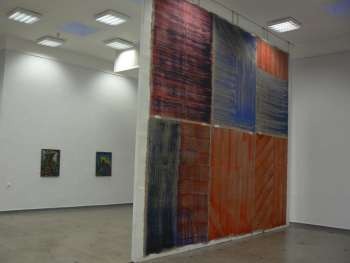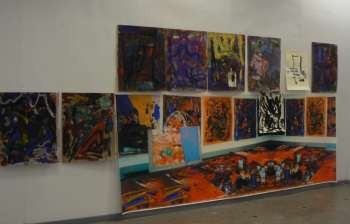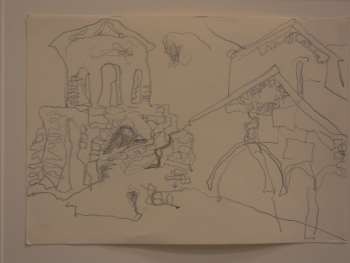TO BE WITH ANOTHER PERSON WHEN YOU ARE ALONE 0
About the exhibition of Arūnas Vaitkūnas “Smell of Life” and book of Aušra Barzdukaitė-Vaitkūnienė “Such is the Smell of Life”Rasa Andriušytė
www.kamane.lt , 2010 01 11
Photo of R. Andriušytė
In brief: As the year 2009 was coming to an end, the painter Aušra Barzdukaitė-Vaitkūnienė presented two works done in memoriam of her late husband, painter Arūnas Vaitkūnas (1956-2005) at Kaunas Picture Gallery. She became the curator of the exhibition “Smell of Life” and the author of the book of recollections “Such is the Smell of Life”. The exhibition and the book is evaluated as an important and interesting event in Kaunas cultural life.
Artists supervising exhibitions as well as actors directing performances do not surprise any more. A.Barzdukaitė-Vaitkūnienė is not a beginner in the field of organising exhibitions. There are not so many artists who can write as well as paint. The painter A.Barzdukaitė-Vaitkūnienė has joined the ranks of such painters already, even though her book is not pure literature but recollections.
“Smell of Life” of A.Vaitkūnas. Sketches from Paris. Photo of R. Andriušytė
The painter A.Barzdukaitė-Vaitkūnienė organised the exhibition and wrote the book of recollections on her own. The crowd of contemporaries of A.Vaitkūnas is really big; still, it is silent at the moment. Only some thoughts of the painter Antanas Obcarskas and the interview written down by the former student Gvidas Latakas is included into the book. Perhaps it is not easy to manage the heritage and to write recollections after a loss of a dear person. It is said that a text (or exhibition) is nothing else but a way to be with another person when you are alone objectively. In this case the experiences of feelings and loneliness turned into personal texts dedicated to the son as well as into a public fact of cultural life. Therefore, it is important to know why the painter has decided to unveil the shade of joint experience of two people in general.
“Smell of Life” of A.Vaitkūnas. Fragment of exhibition at Kaunas Picture Gallery. Photo of R. Andriušytė
An exhibition organised by a curator is usually based on some intellectual idea, pointing out of some important qualities of a personality or creative works. The title of this exhibition “Smell of Life” is a slightly clumsy phrase which does not tell much about its content. Meanwhile, it is exact as an emotional tonometer of the exhibition. The title of the book “Such is the Smell of Life” sounds like a poetry line and, therefore, it suits a publication more than an exhibition.
The relation between the book and the exhibition is very close. It seems that the exhibition serves as fragmented illustrations for the book of recollections. It is also close to the book by its structure: four parts of the exhibition are like four short stories told by images. Such a decision is understandable, especially if one has read the texts of A.Barzdukaitė-Vaitkūnienė in the portal www.kamane.lt. Meanwhile, the exhibition may leave an impression of a fragment rather than creative whole for the ones who did not participate in the artistic life of Kaunas at the end of the 20th century directly.
The exhibition is formed of four parts. The first part covers the longest period from the chronological point of view: paintings or drawings on motifs of staircases. The relation of the world of A.Vaitkūnas with the works of Arvydas Šaltenis, Kęstutis Paliokas, Algimantas Kuras may be felt in this part. The painful look at the world makes their works “one family of paintings”.
Experimental works created using brooms are exhibited in the main hall of Kaunas Picture Gallery. One may see even the brooms used by A.Vaitkūnas. Presenting the “broom” works of the artist in the most important hall of the gallery, the curator gave too much prominence to these works. Meanwhile, they were and remained an unclear and problematic episode of A.Vaitkūnas’ creation. Therefore, the exhibition may create a wrong impression that A.Vaitkūnas is a real abstractionist, although these were only tests and attempts to provoke at the beginning of the last decade of the 20th century.
The curator succeeded to revive the atmosphere of the temporary studio of A.Vaitkūnas in Paris (Cité Internationale des Arts) in the third hall. The “scenography” of the workshop was created by presenting large photographs. The painter himself looks down from the photograph on the back wall. On another hand, the visitor does not clearly understand why the period spent in Paris is given such prominence.
The last exhibition hall is spacious and silent, similar to a church. Only photographs are exhibited on the walls, and they finish the exposition. The last sketches of A.Vaitkūnas hover in this space. Differently from sketches of Kaunas staircases, the ruins of Georgian temples were drawn by an uncertain hand. Lines vibrate and intertwine as if the earth was no longer solid under the feet.
One photograph pictures a colourful company of artists. A.Vaitkūnas is among them but seems to be separated. It is so vivid in the photograph made by an unknown author.
The camera of the mobile phone has captured several looks of the artist: a staircase, ornaments, one more kite rising from twilight towards the sun. Photography as media was important during the last days of creation and life of A.Vaitkūnas.
Sketch of A.Vaitkūnas from Georgia. 2005. Photo of R. Andriušytė
Returning to the book, the art critic states in the article that there are not so many books about artists based on authentic recollections in Lithuania. The best book of the kind issued recently is the book of Laimonas Tapinas about the cinema director Vytautas Žalakevičius. Meanwhile, the book of A.Barzdukaitė-Vaitkūnienė could be compared with “Notes of Female Exile” of Aušra Sluckaitės-Jurašienė. The experience of writing of these two authors cannot be compared; still, both books have been written in the form of stories or novellas, they have features of essays, they do not lack impressions and subjectivity, which turns into an autobiographic sketch sometimes.
The layer of memories is thick in the book of A.Barzdukaitė-Vaitkūnienė; still, memories are expressed in a rather daily manner (Arūnas said, walked, went, painted) instead of more emotional or intellectual way. This is why this book may be estimated as an original piece of literature of testimonies. The story-telling is not hasty. Sometimes the author returns to the theme discussed earlier. This does not hinder the process of reading as the calm tone of writing does not make the reader rush through pages. Also, the illustrations presented along with the text (photographs, sketches, notes) ask to be analysed for some time.
Even though there is only one hero of the book, it is an authentic story about two artists, Arūnas and Aušra full of fragments of a novel and real life, smells and vision. Such is the mood of the book, and it should be accepted in this way. The works of A.Vaitkūnas have a patron worth it, who is knowledgeable enough, loving and bold. It is the main stroke of the double portrait.












